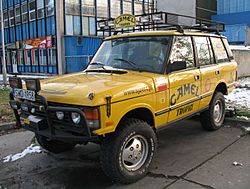Camel Trophy facts for kids
The Camel Trophy was an exciting yearly competition that took place from 1980 to 1998. It was famous for using tough Land Rover vehicles to explore very difficult places around the world. Teams from different countries competed in amazing adventures, testing their driving skills, teamwork, and endurance in some of the wildest environments on Earth.
Contents
What Was the Camel Trophy?
The Camel Trophy started in 1980 as a big team expedition across the Trans-Amazonian highway in Brazil. People often called it the "Olympics of 4x4" because it was all about adventure and exploration.
Early Adventures (1980s)
In its first eight years, the Camel Trophy traveled to many incredible places. These included Sumatra, Papua New Guinea, Zaire, Brazil, Borneo, Australia, Madagascar (the first time anyone crossed it from north to south), and Sulawesi. It even returned to the Amazon!
These events were huge tests of human strength and skill. Teams from all over the world came together, hoping to win against some of the toughest off-road conditions you could think of. Teamwork and trusting each other were super important. The competition included "Special Tasks," like using a winch to pull vehicles out of mud or racing on timed driving routes. Each country's team competed against the others in these challenges.
New Challenges (1990s)
In the 1990s, the Camel Trophy went to new locations like Siberia in the USSR, Tanzania, Burundi, Guyana, Argentina, Paraguay, Chile (known for its "Road to Hell" event), Belize, Mexico, Guatemala, El Salvador, Honduras, Kalimantan, and Mongolia.
The event also changed over time. It wasn't just about driving through mud anymore. It started to include other adventure sports like kayaking, mountain biking, and even winter sports. Teams were chosen through national competitions in each country. These tests checked how good candidates were at sports, engineering, and driving.
Helping the Environment
Even though the events traveled through wild places, the Camel Trophy often helped the local areas. For example, in 1993, teams worked all night to build a special station in the jungle. This station helped biologists study the plants (flora) and animals (fauna) of the area.
Also, the convoys often reopened old roads and trails that people no longer used. They frequently rebuilt bridges and fixed damaged parts of roads, which was a big help to local communities.
The End of an Era
In 1998, the Camel Trophy went back to Argentina and Chile for one of its last big events in Tierra del Fuego. The new Land Rover Freelander vehicle was used, helping competitors travel six thousand miles across snowy, remote areas. This event focused a lot on outdoor activities.
Soon after, Land Rover, a main sponsor, felt the Camel Trophy was changing too much from its original idea of adventure and exploration. They announced they would no longer sponsor future events. This led to the cancellation of the 1999 event, which was planned for Peru.
In 2000, the Camel Trophy tried a new style. It kept the spirit of adventure but had 32 competitors exploring Tonga and Samoa in powerful RIB boats. This boat event was very successful. However, it turned out to be the very last Camel Trophy event.
The Amazing Vehicles
The first Camel Trophy in 1980 used three Jeep vehicles with German teams exploring the Amazon. After that first year, the organizers decided to partner with Land Rover. For the next twenty years, almost every type of Land Rover vehicle was used. This included Range Rovers, Series IIIs, Defenders, Discoverys, and Freelanders. They all had a special "sandglow" colour that made them easy to spot.
These vehicles were heavily changed by Land Rover's Special Vehicles team. They added lots of equipment for expeditions, vehicle recovery, and safety. Some of these special additions included:
- Strong roll cages for safety
- Protection underneath the vehicle and guards for the steering
- Special electrical systems
- Powerful winches to pull vehicles
- Special tow hitches and recovery points
- Snorkels so the engine could breathe underwater
- Transmission breathers for deep water crossings
- Tough Michelin XCL or BF Goodrich Mud and snow tires
- Upgraded suspension and transmission parts for rough terrain
- Extra fuel tanks for long journeys
- Webasto heaters for cold places
- Strong roof racks for carrying gear
- Bright driving, spot, and fog lights
- Bull bars and bush wires to protect the front of the vehicle
- Flag poles, event plaques, and sponsor logos
- Tools like Jerry cans (for fuel), Pelican cases, Zarges boxes, high lift jacks, sand ladders, axes, ropes, and spades
- Garmin, Terratrip, and other navigation and communication equipment
Usually, these special Land Rovers were only used for one event. Some competitors bought their vehicles, and many stayed in the host country. The vehicles that returned to the UK were very popular. They had low mileage, but those miles were "Camel Trophy miles" – meaning they had been through a lot! Land Rover removed most of the special equipment before selling them, but they kept their unique color and Camel Trophy markings.
Images for kids
-
Camel Trophy Land Rover Defender 110 '91 Tanzania-Burundi Communications Unit
See also
 In Spanish: Camel Trophy para niños
In Spanish: Camel Trophy para niños



